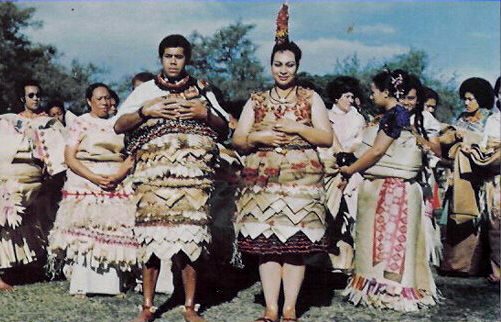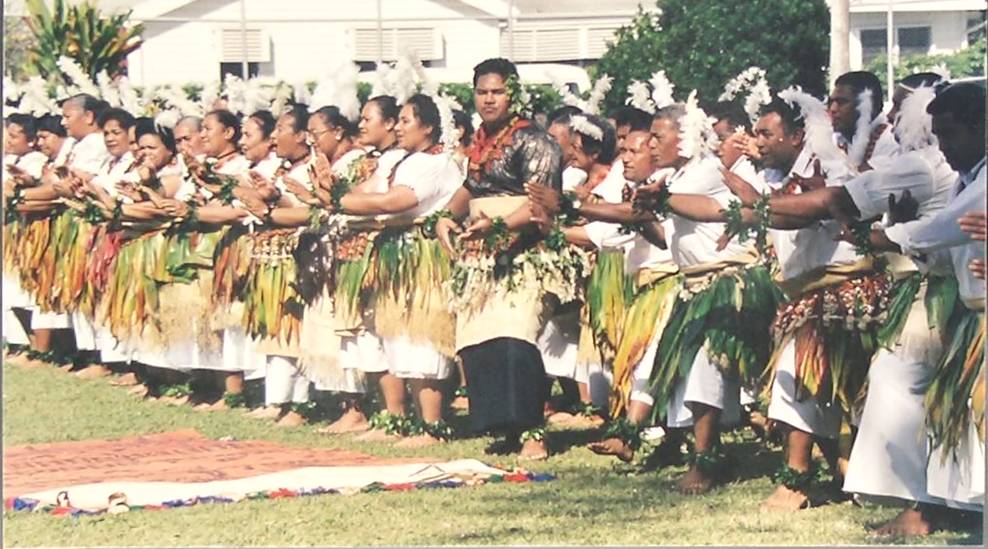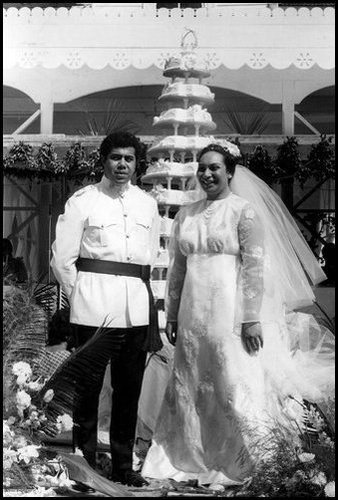Guest Post: Ruth Elayne Kongaika
My first experience attending a royal wedding was when we moved to the island of Tonga. We received an invitation for the Imperial nuptial. I did not know what to expect, but was informed that I must wear gloves and a hat. Tongans must wear traditional clothing, but since I was a foreigner, I wore a long blue empire waist dress with a matching hat and gloves. Princess Salote Pilolevu, daughter of the reigning monarch was to marry Tuita, a cousin. Tongan Royals must marry in the family to retain the strong royal bloodline in order to continue the true line of succession to the throne. That was taboo in the society I grew up in, so it took me a while to get my brain around it.
 I recollect the young beautiful Princess Pilolevu in her wedding attire, and what a contrast it was to bridal gowns I was used to seeing. Extravagant feasting, mostly provided by the commoners, was indulged in by all. There were polas (large wooden trays lined with banana leaves) piled high with whole pigs, lobsters, fish, beef and oodles of local root crops and luscious fruits. The finest the Kingdom had to offer was displayed for the grand occasion. It was a far cry from the quaint receptions of my friends and family with bowls of mints and nuts as refreshments.
I recollect the young beautiful Princess Pilolevu in her wedding attire, and what a contrast it was to bridal gowns I was used to seeing. Extravagant feasting, mostly provided by the commoners, was indulged in by all. There were polas (large wooden trays lined with banana leaves) piled high with whole pigs, lobsters, fish, beef and oodles of local root crops and luscious fruits. The finest the Kingdom had to offer was displayed for the grand occasion. It was a far cry from the quaint receptions of my friends and family with bowls of mints and nuts as refreshments.
Etiquette and decorum were uppermost in the minds of all involved. There was quite a bit of bowing, curtsying, and even crawling on the ground by commoners around the imperial family members. I remember how “star struck” I was when it was my turn to greet Princess Pilolevu. She was very refined in her mannerisms. I had practiced my curtsy well ahead, but it still felt awkward.
 Of course, the activities of the whole island kingdom were put on hold in celebration for the wedding. There was dancing, including whole villages which donned skirts of leaves, feathers and mats all handmade from what the land provided. Months of practice had gone into preparation for a lakalaka, the Tongan National dance. One lakalaka could last as long as thirty minutes, and sometimes seemed it would never end. The song writer and choreographer would usually base the dance on a legend or history of the islands.
Of course, the activities of the whole island kingdom were put on hold in celebration for the wedding. There was dancing, including whole villages which donned skirts of leaves, feathers and mats all handmade from what the land provided. Months of practice had gone into preparation for a lakalaka, the Tongan National dance. One lakalaka could last as long as thirty minutes, and sometimes seemed it would never end. The song writer and choreographer would usually base the dance on a legend or history of the islands.
 Another notable difference between typical Western and Tongan weddings is the cake ceremony. The wedding cake is usually more than ten layers. After the couple has share a piece with each other, each layer of the cake is presented to a person who has played an important role in the wedding. It is their way of honoring those who have helped them.
Another notable difference between typical Western and Tongan weddings is the cake ceremony. The wedding cake is usually more than ten layers. After the couple has share a piece with each other, each layer of the cake is presented to a person who has played an important role in the wedding. It is their way of honoring those who have helped them.
In 2012, there was another royal Tongan wedding. Again, close cousins were united in matrimony. The son of King Tupou VI, the Crown Prince Tupouto’a Ulukalala and Sinaitakala Fakafanua (26th in line for the throne), were united amidst controversy regarding the wisdom of carrying on this age-old practice of arranged marriages.
Interestingly, modern day weddings in Tonga are usually a mixture of British style weddings and traditional Tongan. Family obligations are very important in Tonga, and many sacrifices are made by close and distant kin, which becomes a competition in many instances. It is not unheard of today for the line to include ten or more bridesmaids. Gifts of tapa cloth, quilts, fine woven mats and great deals of money are often lavished on the couple. Hopefully you can experience a lavish Royal Tongan Wedding during your lifetime.
Ruth Elayne Kongaika was raised in the mainland, USA, and has been living in the South Pacific for the past forty years. She enjoys trying to capture the beauty of the Polynesian islands through her photography, painting and writing. She has a blog which shares some of her art and favorite subjects at:
email: kongaikr@byuh.edu












